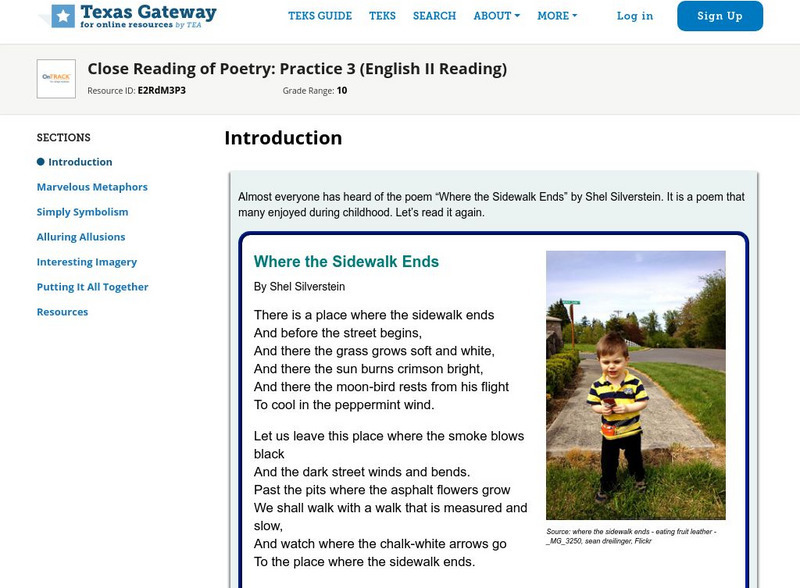Gwinnett County Public Schools
Analysis of the Tuck Everlasting and The Birchbark House Text Exemplars
Looking to introduce some text-based questions into your ELA lessons? Practice the kinds of skills the Common Core demands with the seven text-based questions and the essay prompt provided here. Designed to be a three-day instructional...
Schools United to Provide Enhanced Resources Network
AP English Project: Journal of Literary Terms and Devices
To prepare for the AP English exams, individuals are asked to create a notebook of literary terms and devices. The terms must be defined, accompanied by representative artwork, and illustrated by an example drawn for a named source. A...
Curated OER
Imagery and Emily Dickinson
Seventh graders explore imagery, particularly in relation to figurative language.
Curated OER
Storytellers: Bruce Springsteen
Students use the music of Bruce Springsteen to learn literature techniques.
Curated OER
Keeping the Dream Alive
Students explore the life and works of black American playwrights to gain insight into how their works reflect and influence the black American experience.
Curated OER
Simile Stories
Fourth graders view song lyrics and identify similes in the song text. In this similes lesson, 4th graders define and identify similes on a worksheet. Students write their own similes using various adjectives.
Curated OER
Colorado Animals Newsletter and Directed Web Page
Students select a Colorado animal, develop a Directed Web page, and research their animal. Each member of the group combine their research and develop a Newsletter.
Curated OER
Analysis of Character in a Short Story
Ninth graders examine a character from the short story, John Steinbeck's, "Flight." students respond to questions about the story and illustrate the character's journey.
Curated OER
Identifying Figurative Language
In this figurative language worksheet, students identify figurative language in the sentences and explain their answers. Students complete 10 problems.
Curated OER
Recognizing Similies: Fast as a Whip
Students review what they have already learned about similies and begin to engage with similies on a deeper and more abstract level as they create their own.
Curated OER
Original Line or Familiar Find?
Students examine a primary source document from 1684 that includes many of the same lines found in Romeo's speech to Juliet from Shakespeare's Romeo and Juliet. Students compare the texts and discuss authorship during the sixteenth and...
Curated OER
Technology-commected Folklife Lesson Plan: Fables
Young scholars discuss ways the stories were alike and different. The teacher demonstrate how to draw a Venn diagram using Microsoft Word. They label the two circles and enter the likenesses and differences on the diagram.
Curated OER
Alliteration
Students write and illustrate a sentence which names a letter of the alphabet. The sentence should have subject, verb, describing words, and incorporate alliterative techniques.
Curated OER
Legends of the Fifth
Fifth graders discover the difference between myths, legends, and folk tales. They summarize legends. They work together to dramatize legends and then create their own legend using the writing process. Handouts and worksheets are included.
Curated OER
VH1 Driven: Kanye West, Lesson 2
Young scholars compose an original rap. They discuss the career and music of Kanye West, discuss their pre-writing worksheet, and write an original rap using a Final Draft Worksheet.
Curated OER
Using Scholastic News to Introduce the Net
Third graders log on to the net, type in the address for Scholastic and browse the subjects for the week. They select one area of interest and generate five interesting facts about the article.
Texas Education Agency
Texas Gateway: Close Reading of Poetry: Practice 2 (English I Reading)
[Accessible by TX Educators. Free Registration/Login Required] Through this practice lesson, students will learn how to interpret poetry. They will learn how to spot a metaphor, to identify imagery, and be introduced to the terms...
Texas Education Agency
Texas Gateway: Close Reading of Poetry: Practice 3 (English Ii Reading)
Doing the exercises in this lesson will help students comprehend the poet's meaning by giving them practice in finding imagery, metaphors, symbolism, and allusions. RL.9-10.9 alllusions to other works.
Texas Education Agency
Texas Gateway: Close Reading of Poetry: Practice 2 (English I Reading)
[Accessible by TX Educators. Free Registration/Login Required] As you work through this lesson, you will learn how to interpret poetry. You will learn how to spot a metaphor, you will learn to identify imagery, and you will be introduced...
Texas Education Agency
Texas Gateway: Close Reading of Poetry: Practice 2 (English I Reading)
Read carefully in order to identify allusion, imagery, metaphor, and symbolism and to evaluate their impact on the meaning of a text. RL.9-10.9 alllusions to other works.
Texas Education Agency
Texas Gateway: Literary Text: Close Reading of Poetry: Practice 3
This lesson will help you comprehend the poet's meaning by giving you practice in finding imagery, metaphors, symbolism, and allusions.
Texas Education Agency
Texas Gateway: Close Reading of Poetry: Practice 3 (English Ii Reading)
Read carefully in order to identify allusion, imagery, metaphor, and symbolism, and evaluate their impact on the meaning of a text.
ReadWriteThink
Read Write Think: Reader Response in Hypertext: Making Personal Connections
Students write a narrative of place, a character sketch, an extended metaphor poem and a persuasive essay then link all four texts to quotations they have selected from a novel.
National Endowment for the Humanities
Neh: Edsit Ement: Introducing Metaphors Through Poetry
This lesson is designed to help young scholars begin to engage with metaphors on a deeper and more abstract level. The lesson will begin with a poem containing metaphors accessible at all levels, and with each poem, the lesson will...























